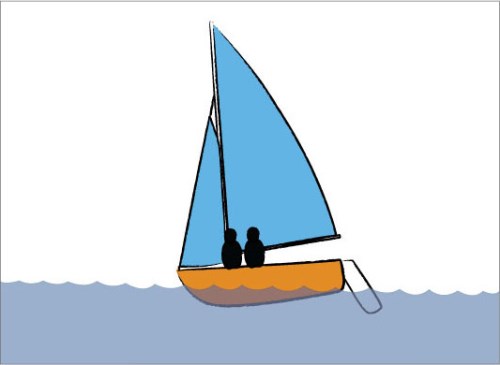Seamanship - Sailing without a Centreboard
Go To: Sailing - Techniques and Manoevres
Posted on 16 October 2009 18:41
Several seamanship skills are firmly centred around helping you deal with, or sail in, what are termed adverse conditions; this is usually when something is not working properly. Centreboardless sailing is one of these skills.
The obvious other one is rudderless sailing, and the not so obvious are anchoring and reefing. Centreboardless sailing is one of the easier skills to learn.
First of all, let’s explore why we sail with a centreboard. It has two functions – one is to provide opposite force to the wind against the sail, which through the lift principle generates forward movement, although the centreboard is not essential for this – the boat will move forwards without it. The other key function is to stop sideways drift of the boat when attempting to move in an upwind direction.
This is the function we need to be able to at least partly replicate without a centreboard. The boat will still move forwards without a centreboard, but at a big price – it will drift sideways terribly. So, why does the centreboard stop us moving sideways usually? The answer is because of its shape, it acts as a keel or rudder of sorts and provides sideways resistance.
So, if we need to sail without a centreboard, we need to find something we can use that has a similar shape or will provide a similar function. If you’re on land and can improvise then there are plenty of ideas, but let’s concentrate on what we might have available when we’re out at sea. The key one, for most boats, will be the bow of the boat.
If you’re sailing a “traditional” displacement hull boat, such as a GP14 or an Enterprise, you’ll find the bow is quite pointy, with an edge. Therefore if you can get enough of the bow into the water, it will act somewhat like a centreboard and stop you moving sideways. It won’t work as well as a centreboard – but it will work well enough for you to make better upwind progress than you would otherwise.

Diagram 1: Sit forward to dig the bow in when sailing with no centreboard
How do you get the bow into the water? It’s quite simple – you move your weight as far forwards as possible, even to the point where the crew is sitting on the deck if necessary. This will cause the front or bow of the boat to dig in the water. The pointy front will then act like a skeg (a fin or protrusion under the waterline) and help guide the boat in more of a straight line.
Now this won’t work on all types of boats; as previously mentioned, it needs to be a displacement style hull, such as an Enterprise, or a GP14. On boats that have hulls that don’t displace as much water (typically planing hulls that are flatter with less of a pronounced bow), such as a Laser, or performance boats such as an RS500, this technique should still work but it will not work as well, and if you are sailing a skiff then good luck, as they are generally too flat for this to work at all. We practised this recently in a Lark, which with a quite pointy nose works very well – we managed to sail from a leeward to windward mark, about 500 metres, in more or less the same amount of tacks we would normally.
When might you need this? Well, not just if your centreboard or daggerboard breaks or you can’t get it down, which are the obvious choices. Many people sail on shallow lakes or rivers, or on tidal estuaries where the water can be very low at times with very little depth, and it may be hard to put a centreboard or daggerboard down. This will usually be more of a problem with daggerboard style boats, as a centreboard that pivots can usually be put down a little (enough to give sufficient sideways resistance to move). Daggerboard boats would therefore benefit more, but as previously mentioned, most daggerboard boats tend to be planing or skiff type hulls which this technique will not work very well on.
Summary
So, to summarise – if you find yourself in a situation where you cannot use centreboard or daggerboard – get your and your crews’ weight forward, dig the nose of the boat in, and make the best progress you can.